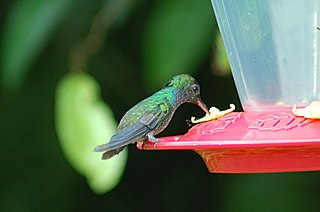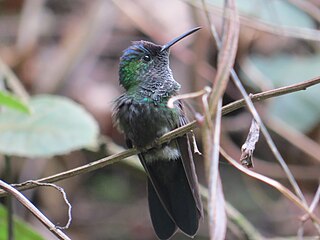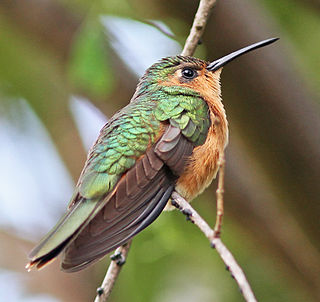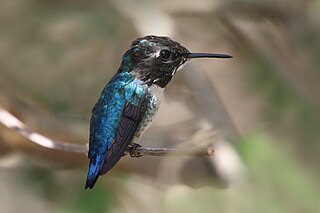
Microchera is a genus of hummingbirds.

The charming hummingbird and also known as the beryl-crowned hummingbird is a species of hummingbird in the family Trochilidae, found in Costa Rica and Panama. Its natural habitats are subtropical or tropical moist lowland forest and heavily degraded former forest. Staying within the exterior of forests, it searches for scattered flowers and various arthropods for food.

The purple-chested hummingbird is a species of hummingbird in the family Trochilidae. It is found in Colombia and Ecuador. Its natural habitats are subtropical or tropical moist lowland forest and heavily degraded former forest. It is commonly hunted for the supposed medicinal properties of its beak by indigenous peoples in the area.

Eupetomena is a genus in the hummingbird family Trochilidae. It contains two species which are both found in eastern South America.

Goldmania is a genus in the family of Hummingbirds, and consists of 2 species.

The white-chinned sapphire is a species of hummingbird in the family Trochilidae. It is found in northern South America. Its natural habitats are subtropical or tropical moist lowland forest, subtropical or tropical dry shrubland, and heavily degraded former forest.

Woodnymphs are hummingbirds in the genus Thalurania. Males are green and violet-blue, while females are green with white-tipped tails and at least partially whitish underparts. Both sexes have an almost straight, entirely black bill and little or no white post-ocular spot. They are found in forest and tall second growth. The species in this genus are almost entirely allo- or parapatric, and a species is present virtually everywhere in the tropical humid Neotropics.

The fork-tailed woodnymph is a species of hummingbird in the "emeralds", tribe Trochilini of subfamily Trochilinae. It is found in every mainland South American country except Chile and Uruguay.

The violet-capped woodnymph is a species of hummingbird in the "emeralds", tribe Trochilini of subfamily Trochilinae. It is found in Argentina, Brazil, Paraguay, and Uruguay.

The Mexican woodnymph is a species of hummingbird in the family Trochilidae endemic to western Mexico. It lives in subtropical or tropical moist lowland/foothill forest and plantations, feeding on flower nectar and insects. Mexican woodnymphs are vulnerable, threatened by habitat loss through deforestation.

The long-tailed woodnymph is a species of hummingbird in the family Trochilidae. It is found in humid forest in northeastern Brazil, where it is known from the states of Pernambuco, Alagoas, Sergipe and the northernmost Bahia. It is usually thought to be widespread, but seen at low density in its increasingly fragmented range. Its population is estimated to be around 1,000–2,500 individuals, currently in decline due to deforestation and habitat loss.

Saucerottia is a genus of birds in the family Trochilidae, or hummingbirds.

Polyerata is a genus of hummingbirds.

The crowned woodnymph or violet-crowned woodnymph is a species of hummingbird in the "emeralds", tribe Trochilini of subfamily Trochilinae. It is found from Belize and Guatemala to northern Peru.

Pampa is a genus of birds in the hummingbird family Trochilidae. These species are resident in northern Middle America.

Elliotomyia is a genus in the family of Hummingbirds.

Lesbiini is one of the two tribes that make up the subfamily Lesbiinae in the hummingbird family Trochilidae. The other tribe is Heliantheini (brilliants).

Mellisugini is one of the three tribes that make up the subfamily Trochilinae in the hummingbird family Trochilidae. The other two tribes in the subfamily are Lampornithini and Trochilini (emeralds).

Lampornithini is one of the three tribes that make up the subfamily Trochilinae in the hummingbird family Trochilidae. The other two tribes in the subfamily are Mellisugini (bees) and Trochilini (emeralds).

Ramosomyia is a genus in family Trochilidae, the hummingbirds, that was created in 2021 to replace Leucolia.





























